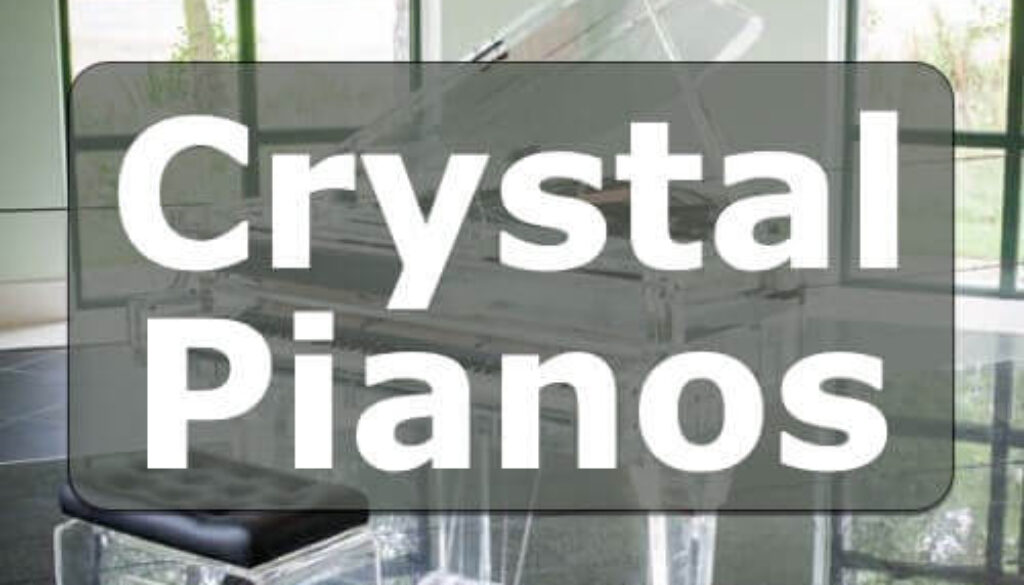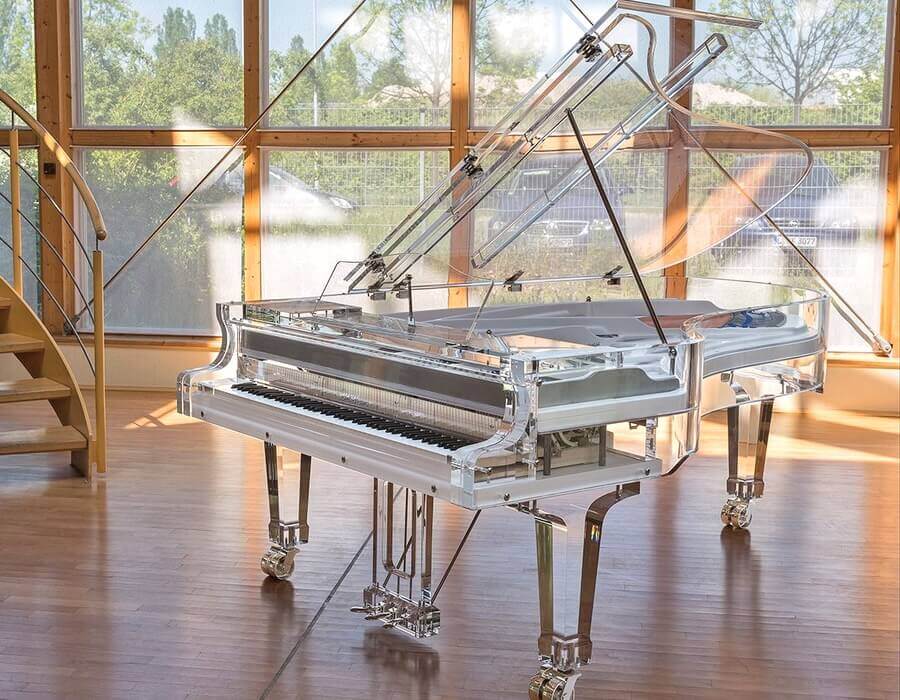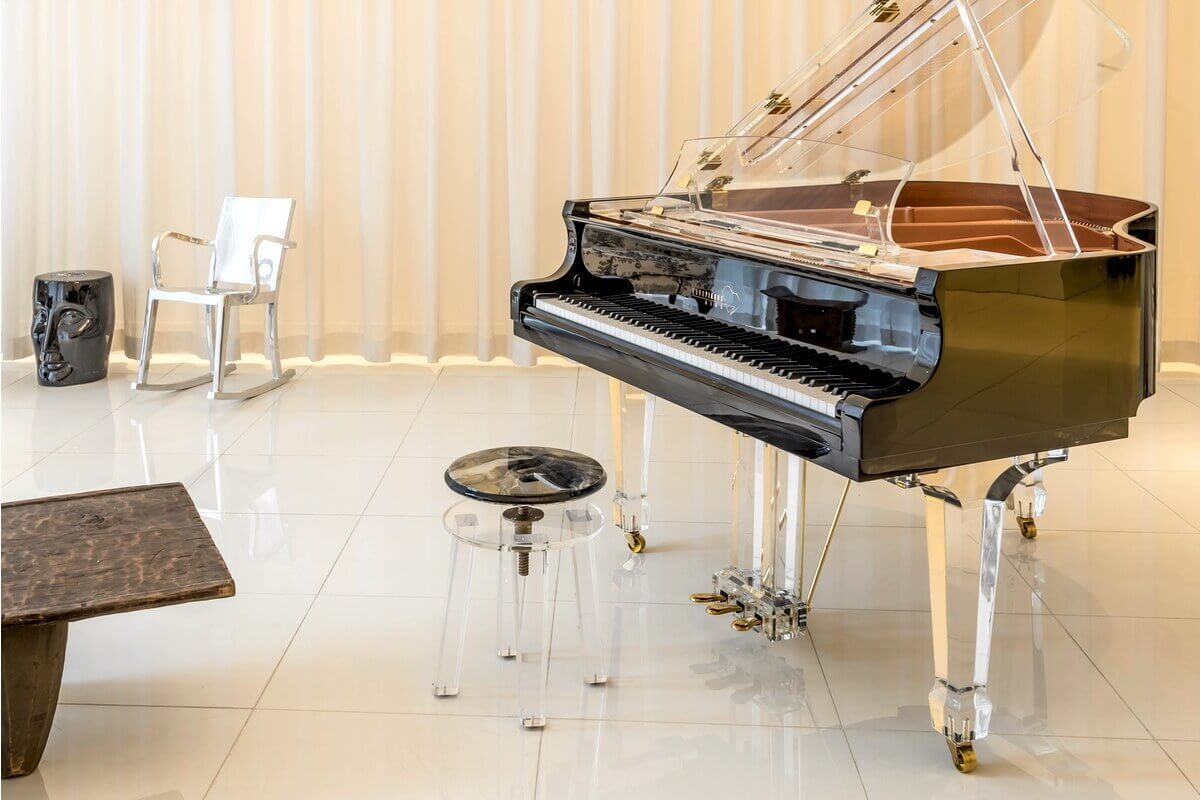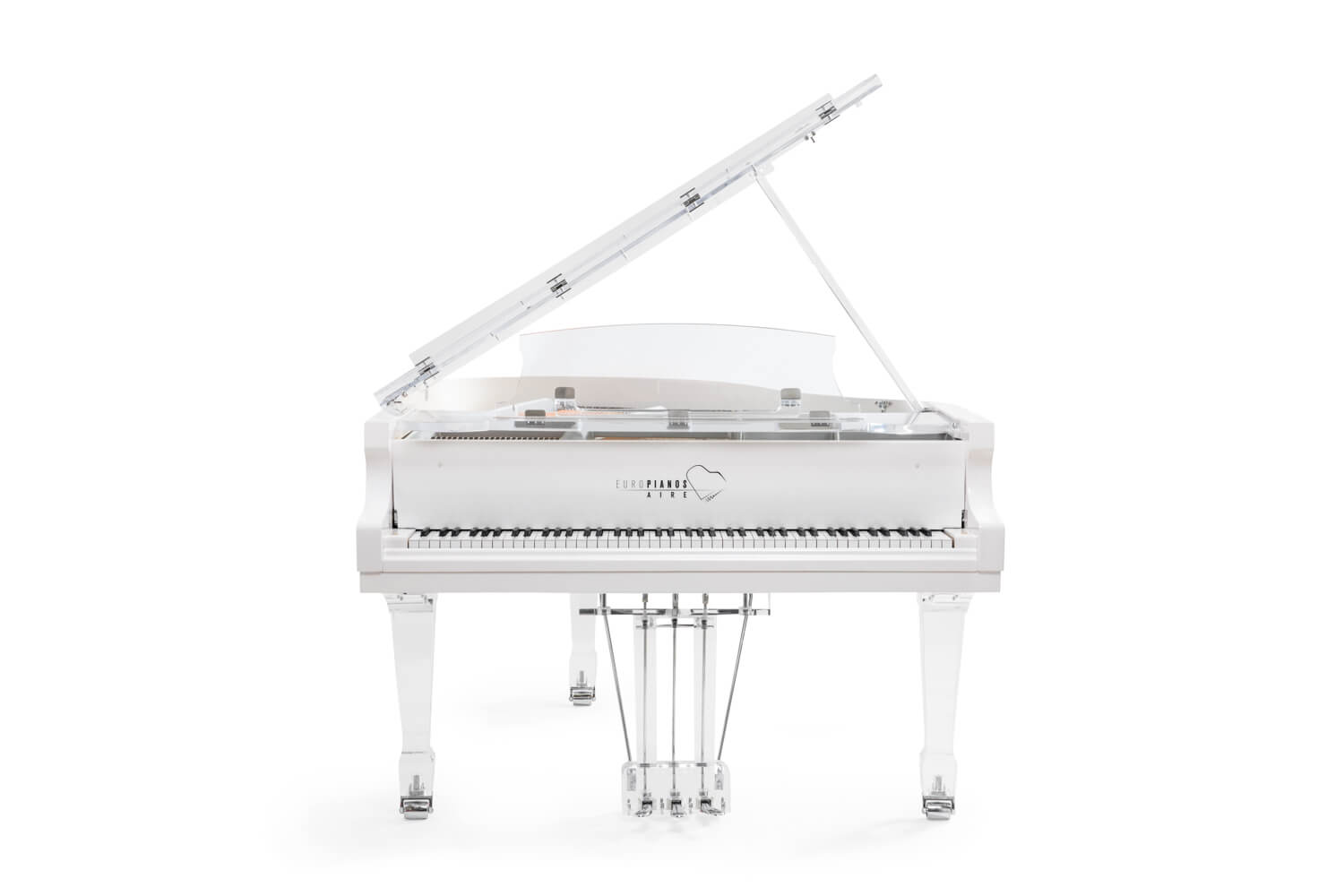Crystal Pianos: Are They Really Made Out Of Crystals?
First of all, we need to establish what we’re talking about. Do we really mean Crystal Pianos?
The only “real” crystal piano we know, a collaboration between Steinway and a British artist, Lauren Baker under the name of Goldfinch, is encrusted with a half million authentic Swarovski crystals, hand glued over a six-month period, commissioned by a wealthy client in the Middle East.
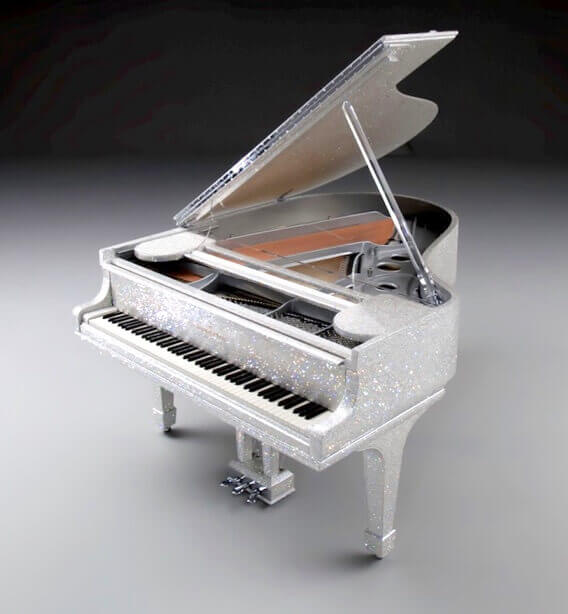
Goldfinch Swarovski crystal piano
The late celebrated pianist, Liberace, who collected pianos and preferred Baldwins, had a grand piano entirely studded with rhinestones (and an automobile too!) which was sometimes referred to as a crystal piano. He also had several covered with tiny mirrors.
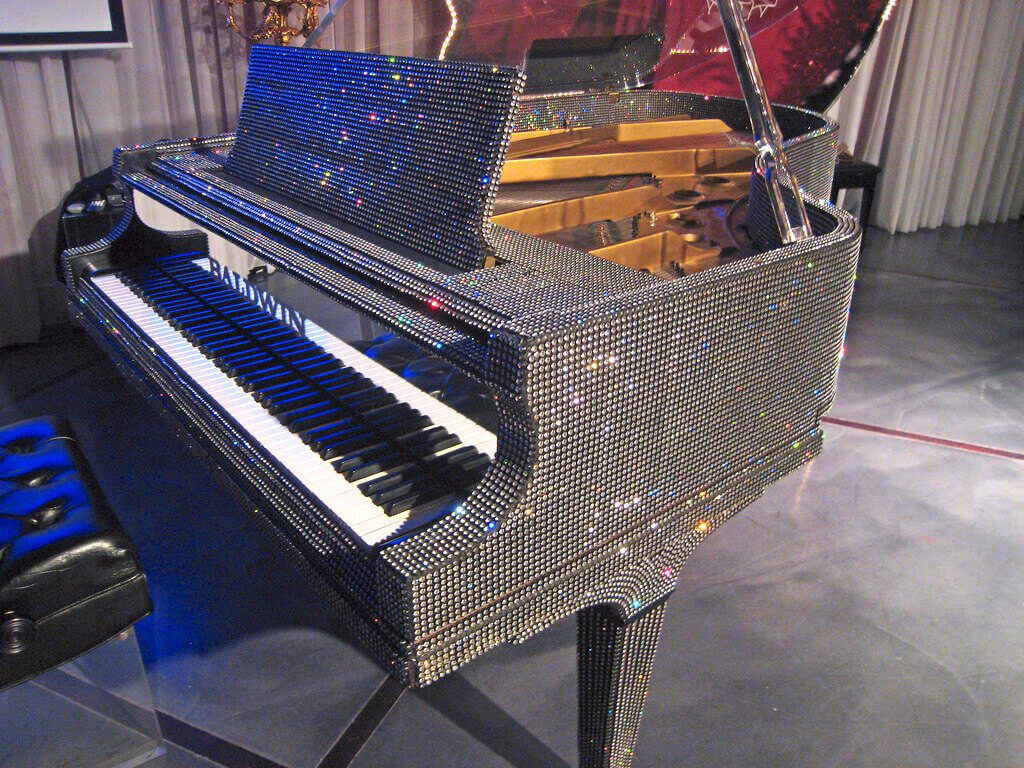
But more often than not, when one hears “crystal piano,” it means the head-turner in the piano industry these days, a transparent piano, which is built with see-through plastic material. The transparent material allows an interesting view into the interior workings of the instrument and creates a lightweight buoyant aspect to an otherwise heavy piece of furniture. These acrylic pianos are called by different names: Crystal, Transparent, Lucite, Plexiglas, and the most generic, Acrylic. One famous piano builder uses the German spelling, calling it a Krystal piano.
The Heintzman Crystal Piano holds the title of the most expensive piano to date, at the cool price of $3.22 million, built to promote the Beijing Olympic Games. The nine foot long concert grand made completely of acrylic (and always referred to as crystal) made its debut during the opening ceremony of the Olympic Games. This piano was sold to an anonymous bidder in an auction after the invigorating performance by world famous pianist, Lang Lang,
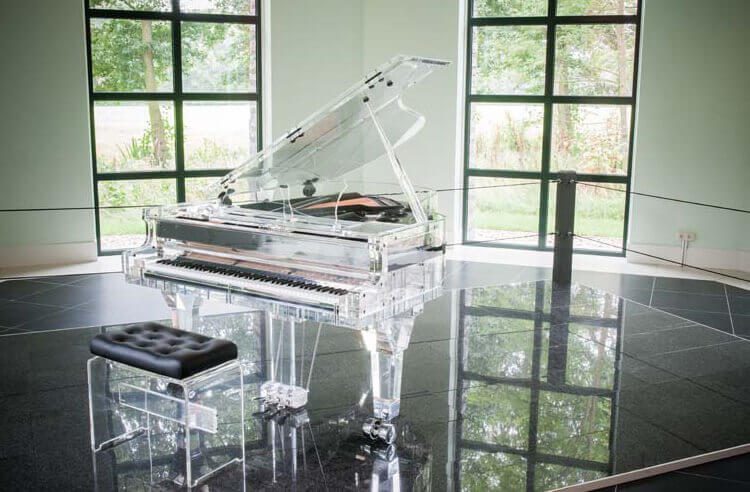
What Is Acrylic? Is It Plastic Or Plexiglas?
Acrylic is a clear (unless it’s dyed) very high-grade form of plastic made primarily from petroleum. Plexiglas (Acrylite) is one of big brand name manufacturers, as is Lucite (Perspex). Although acrylic is a form of plastic, it should not be confused with imitation plastic products which quickly yellow and discolor. But like anything else, there are superior and inferior acrylics, in terms of their ease of use and manufacturing requirements.
There are two basic versions of acrylics: cast and extruded. Cast acrylic is produced by mixing the acrylic liquid in molds. Four acrylic plates between two glass plates where a chemical process in the mold creates a homogenous material with equivalent properties in all directions. In contrast, extruded acrylic is produced by continually pushing the acrylic mass through a form, while the chemical process takes place.
Cast acrylic is usually regarded as a better quality than the extruded, and in fact are two different materials. The cast acrylic is more resistant to some solvents. When laser cutting both, the cast acrylic creates no burrs. Extruded acrylic can behave differently depending on how it’s bent whereas it makes no difference in cast acrylic. Cast acrylic is more scratch resistant, but is harder to flame polish (the finishing process to remove saw marks, prep marks, etc.). Cast acrylic is produced in many thicknesses and colors, which are more limited for extruded acrylic.
Internal tensions in acrylics can cause cracks when cutting it. There is more tension in extruded acrylic.
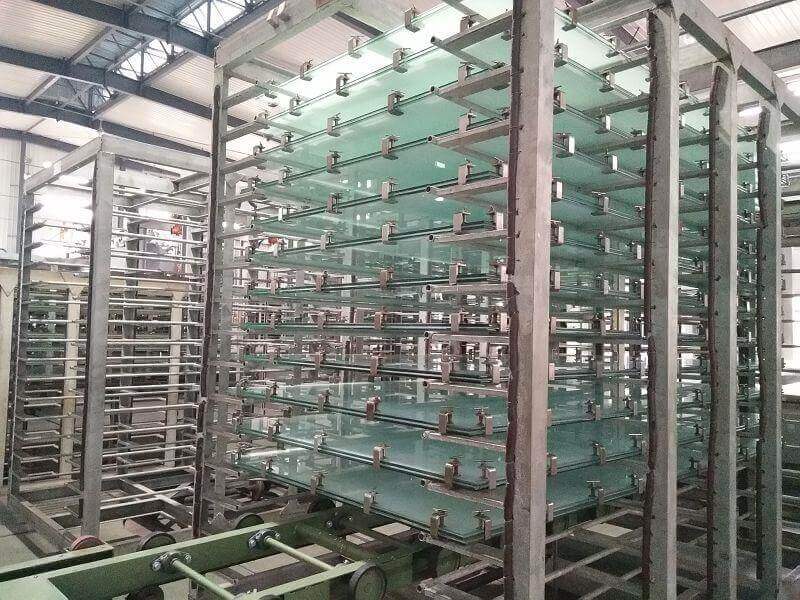
Why Not Use Glass Instead?
There are myriad reasons for using acrylics instead of glass. Even Cinderella might prefer her ballroom slippers be acrylic because they are much stronger than glass, more impact resistant, safer and actually let more light in. Imagine a guest dropping his highball on your glass grand piano and shattering it? It won’t happen with acrylic. The material cleans up with just a mild soap and water swipe, and even scratches in acrylic can be easily buffed out. As a matter of fact, a slab of acrylic, about an inch thick, is bullet proof, that’s how strong it is. Acrylic, unlike glass, can be sawed, glued and designed into shapes and most importantly acrylic weighs 50% less than glass.
Why Is Acrylic Furniture Expensive?
Acrylic is manufactured in sheets before it’s cut, constructed and designed into furniture. The thicker the sheet, the more difficult the process is to maintain the crystal clarity that is desired for furniture, requiring additional costs. Since the product is primarily made from petroleum, its price is linked to volatile oil prices as well. Expensive acrylic can be thick and luxurious, crystal-like, seamless; cheap acrylic has a noticeably more plastic look and feel. But that’s not to say it can’t still do the trick and look great in the context of your interior. Acrylic furniture creates lightness in a room, giving an airy cheerful, sometimes even whimsical, aspect to decor.
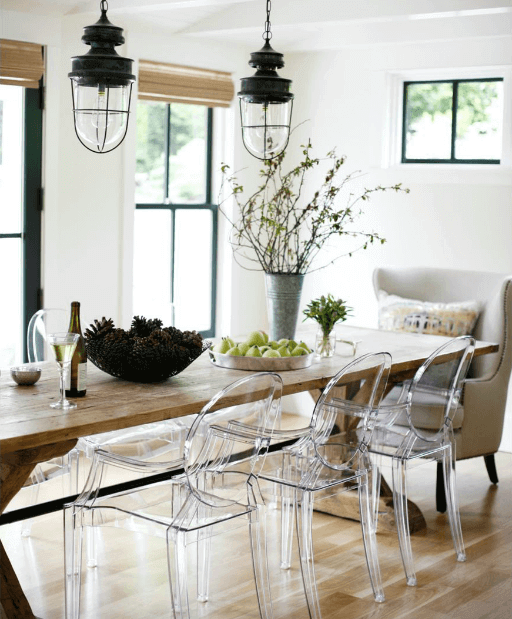
On the piano builder’s part, and that of many furniture designers, the seasoned professional workers are accustomed to wood – so acrylic professionals who design and build acrylic command high salaries and are not always easy to find. A lot of fine pianos and furniture are fundamentally handmade, not machine tooled, thus also raising costs.
What Are The Best Acrylic Pianos On The Market?
Whenever you discuss “the best” in pianos, the conversation rightly refers to the quality of the mechanics and action under the lid – where all the knowhow of 300 years of piano building is manifest in varying degrees. Handmade European pianos are going to outscore machine-tooled pianos that deliberately keep costs down and attract a specific market. The buyer, his budget, and the sophistication of the buyer’s musical ear are the most important deciders when judging what piano would be best for any individual.
In the industry, where professional musicians, technicians, and critics flourish, “the best” means very different things to different people. The desired sound may be a clarity of tone, and/or warmth, richness, mellowness, purity with a short or long sustain, sonorous, or hard-edged, to mention only a few. Touch can differ by key response, key weight, stability, ruggedness. Are the cosmetics of the instrument as important as its musicality? All preferences are individual and different models and makers of pianos supply different sounds and touches, as well as differences in the design of the cases, the decorative values, the artfulness of designs. That’s just a long way of saying that “the best” is always a subjective call.
Generally speaking, higher quality and innovative designs increase the costs and the desirability of an instrument, so maybe the question should be: what are the best quality acrylic pianos on the market?
What Are The Best Quality Acrylic Pianos?
There are several high-end piano builders today making acrylic pianos.
BLUTHNER, a privately-owned family business, has been making pianos of the highest quality in Leipzig, Germany, since 1853 and today boasts the world’s most extensive selection of transparent “Lucid” grand pianos.
Bluthner’s Lucid iDyllic Excellence piano jumps to the top of the list. A fully transparent grand piano which appears to be floating, is the culmination of over 160 years of piano manufacturing and innovation by the Blüthner Pianoforte Fabrik. Many piano builders of acrylic grands used bulky wooden support beams and countless unsightly bolts. The Blüthner Pianoforte Factory has patented the process of securing the soundboard to truly create a fully transparent grand piano. This instrument’s translucency gives it the look of a fragile glass sculpture, while the durable acrylic ensures that it will continue to look pristine and unbreakable. Bluthner buys Plexiglas from Evonik, top rated in acrylics in Europe.
SCHIMMEL began making pianos in Leipzig in 1885. Among European piano makers, Schimmel was a pioneer in the use of computer-aided design and manufacturing. The company has used its Computer Assisted Piano Engineering (CAPE) software to research, design, and implement virtually every aspect of making a piano. Schimmel maintains that the combination of CNC machinery and handwork leads to better results than hand-craftsmanship alone.
The Schimmel Grand K 213 Glas is another quality acrylic grand piano. Schimmel introduced the first transparent piano in 1951 and 30 years later, perfected the design. Now the K213 is one of their flagship models in the grand piano class.
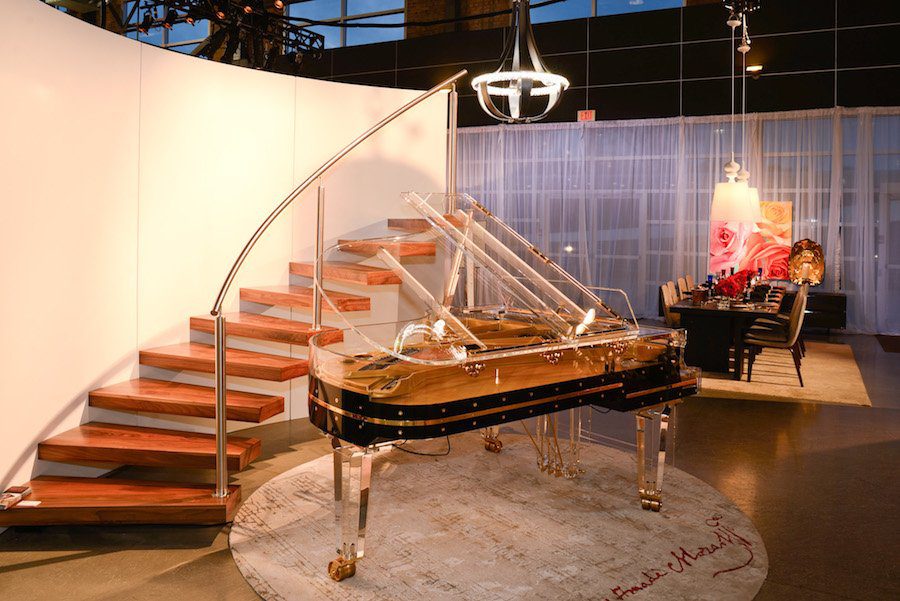
Schimmel’s K213 Glas grand piano
KAWAI, a line of Japanese pianos, also makes a notable acrylic grand, the CR40 crystal piano. Kawai ‘s ultimate efforts to produce a world-class piano paid off and gave them brand name recognition on the list of high quality piano builders.
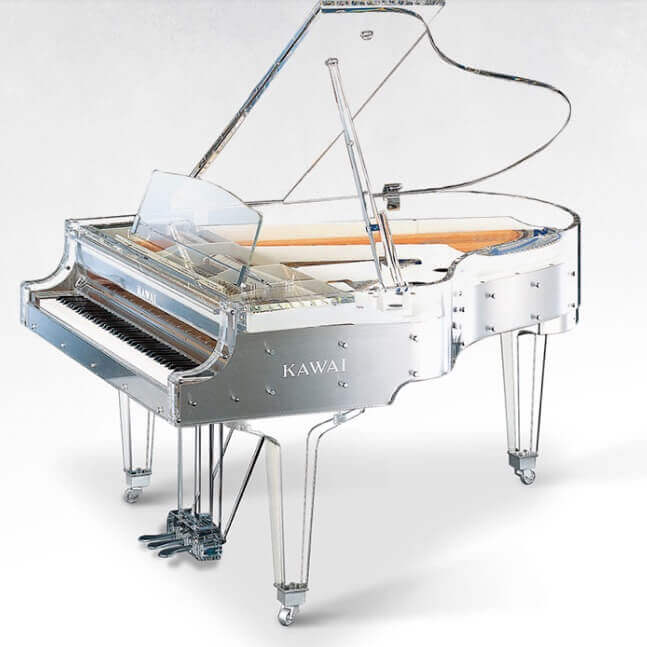
Kawai CR40 Crystal grand piano
Of course, as mentioned before, quality usually denotes expensive. Indeed, Bluthner Schimmel and Kawai prices run in six figures.
EURO PIANOS NAPLES, based in Naples, Florida, designed an affordable quality acrylic baby grand piano (built in Miami using 100% US made acrylic) for clients desiring a more affordable transparent piano.
Bringing a new piano to the marketplace required a lot of research and development. Over months of intensive study, a team of specialists including among them an engineer and pianists, created the acrylic baby grand piano named “Aire.”
The standard 5’3″ wooden piano case can be ordered in polished ebony, white or red with beautiful acrylic legs, lid, lyre and music desk. The clear elements added to the case make the piano look as if it’s floating on air, thus the name designated for this little beauty. It has all the magical look of a European crystal piano priced in the mid to high six figures while being a budget-pleasing acrylic piano in the $50K range.
Why is there such a price difference between these pianos? The answer is that the quality of a grand piano handcrafted by the very best German piano builders will always be superior to (and more expensive) than the best consumer grade piano. For the normal home, concert-level performance quality is not a requirement.
Crystal pianos are often desired for their decorative value as well as being a fully usable musical instrument, designed for a lifetime of pleasure. And while the Aire™ is not using German acrylic for its components, it is using a very high quality, but less expensive American acrylic.
The Aire™ piano has a wooden rim, spruce soundboard and full-sized high-performance piano action. The acrylic components do not interfere with the sound or performance quality.
The Aire™ can be customized with the addition of a wireless PianoDisc player system that brings performances by top artists to your living room and extends the usefulness of the piano. Today’s high definition player systems are invisible, store hundreds of hours of music, have a full orchestra and voice accompaniment, and do not impact playability of a piano.
What About The “Other” Knock-Off Acrylic Grand Pianos?
It would be remiss to ignore the so-called crystal pianos advertised at ridiculously low prices on the internet. Like anything else, quality costs money, and let this serve as a warning: If it sounds too good to be true, it is.
No sooner had Euro Pianos designed and marketed their affordable Aire, when Chinese knockoffs began to appear online, undercutting the already vastly-reduced price of Aire’s crystal piano. How could they do this?
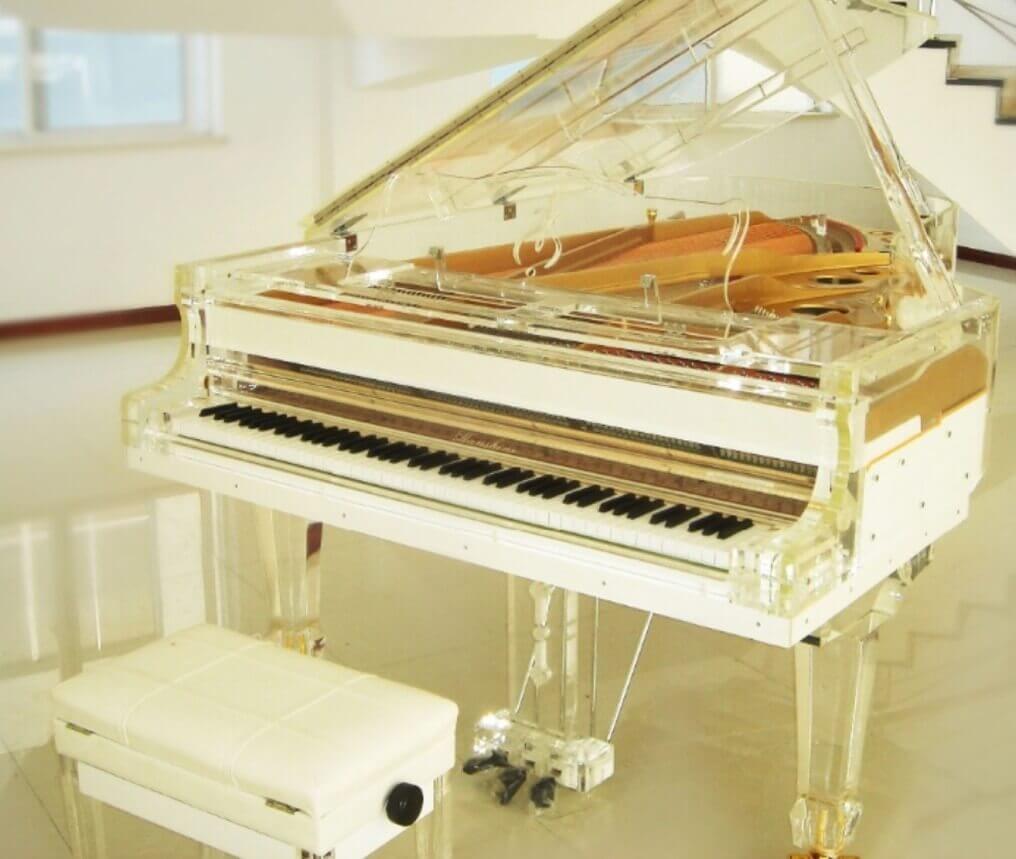
American acrylic (and of course, highly-rated European Evonik acrylic) is extremely resistant to yellowing or discoloration. If you look at the bubble canopies of World War II bomber planes made of Plexiglas, they are still clear after a half-century of sitting in the sun
Non-genuine acrylic yellows quickly. It also becomes brittle. Styrene, PETG, and Polycarbonate have their own suitable uses, but for acrylic pianos or furniture, they are NOT suitable. So, buyer beware.
Check that the plastic used in the piano is truly acrylic before accepting such a cheap price. Also consider the quality of the hardware and the quality of the actual piano. You don’t want pitted and rusted metal in a piano that doesn’t work. Do your research before you buy!

